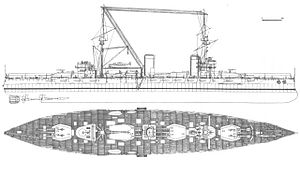Russian battleship Imperator Nikolai I (1916)

Plan and side views
|
|
| Class overview | |
|---|---|
| Name: | Imperator Nikolai I |
| Operators: |
|
| Preceded by: | Imperatritsa Mariya class |
| Succeeded by: | Sovetsky Soyuz class |
| Planned: | 1 |
| Cancelled: | 1 |
| History | |
|
|
|
| Name: | Imperator Nikolai I |
| Namesake: | Nicholas I of Russia |
| Operator: | Imperial Russian Navy |
| Ordered: | 12 September 1914 |
| Builder: | ONZiV, Nikolayev |
| Cost: | 45,080,000 rubles |
| Laid down: | 28 April 1915 |
| Launched: | 18 October 1916 |
| Renamed: | Demokratiia (Democracy) 29 April 1917 |
| Fate: | Transferred to the Ukrainian Navy in 1918 |
|
|
|
| Name: | Demokratiia |
| Namesake: | Democracy |
| Operator: | Ukrainian Navy |
| Renamed: | Soborna Ukraina, 25 January 1919 |
| Fate: | Transferred to the Soviet Navy in 1919 |
|
|
|
| Name: | Soborna Ukraina |
| Namesake: | Union of Ukraine |
| Operator: | Soviet Navy |
| Renamed: | Demokratiia |
| Fate: | Scrapped beginning 28 June 1927 |
| General characteristics | |
| Type: | Battleship |
| Displacement: | |
| Length: | 182 m (597 ft 1 in) |
| Beam: | 29 m (95 ft 2 in) |
| Draught: | 9 m (29 ft 6 in) |
| Installed power: | 29,700 shp (22,100 kW) |
| Propulsion: |
|
| Speed: | 21 knots (39 km/h; 24 mph) |
| Complement: | 1,174 |
| Armament: |
|
| Armor: |
|
Imperator Nikolai I (Russian: Император Николай I or Emperor Nikolai I) was a Russian dreadnought built during World War I for service in the Black Sea. She was designed to counter multiple prospective Ottoman dreadnoughts which had been placed under order by the Ottoman government, since this raised the possibility that the Russian dreadnoughts being built for the Black Sea Fleet could be outclassed. The ship used the same main armament as the preceding Imperatritsa Mariya class, but was larger and more heavily armored. Imperator Nikolai I was launched in 1916, but construction was suspended on 24 October 1917. The Soviets considered completing her in 1923, but later rejected the idea. She was towed to Sevastopol in 1927 and scrapped.
Imperator Nikolai I was designed in response to efforts by the Ottoman Empire to acquire modern dreadnoughts from abroad. By late 1913 it appeared that the Turks would be able to muster three dreadnoughts, two of which were armed with 13.5-inch (343 mm) guns, versus the three Russian dreadnoughts of the Imperatritsa Mariya class then building. A modified version of that class would be the quickest to put into service and the preliminary design work began in December of that year, well before she was formally ordered on 12 September 1914. She was a much bigger and more heavily armored ship than the earlier ships, but her guns and machinery were virtually identical to those of the Imperatritsa Mariya class to save time.
Imperator Nikolai I was considerably larger than the preceding Imperatritsa Mariya class. She was 182 meters (597 ft 1 in) long overall, had a beam of 29 meters (95 ft 2 in) and at full load a draft of 9 meters (29 ft 6 in). The ship displaced 27,830 metric tons (27,390 long tons) at standard load, over 3,000 metric tons (3,000 long tons) more than Imperatritsa Mariya's displacement of 23,413 metric tons (23,043 long tons), and 31,877 metric tons (31,374 long tons) at full load. High-tensile steel was used throughout the hull with mild steel used only in areas that did not contribute to structural strength. The hull was subdivided by 20 transverse watertight bulkheads. The engine room was divided by two longitudinal bulkheads between frames 95–107 and a centerline bulkhead divided the condenser compartment. The double bottom was 1.2 meters (3 ft 11 in) deep and she was given an ice-breaking bow, probably in the hopes that she'd be able to operate outside the Black Sea. Frahm anti-rolling tanks were fitted on each side to reduce her rolling motion. She had two electrically driven rudders on the centerline, the main rudder abaft the smaller auxiliary rudder. Imperator Nikolai I's designed metacentric height was 1.2 meters (3.9 ft).
...
Wikipedia
